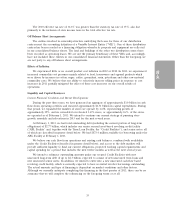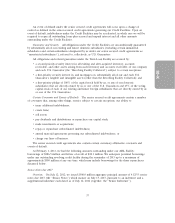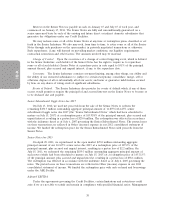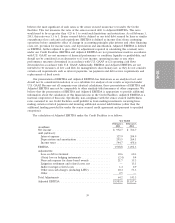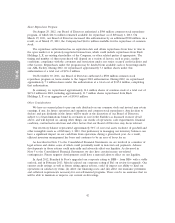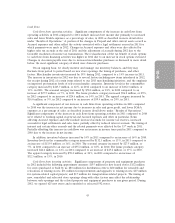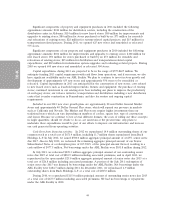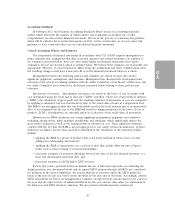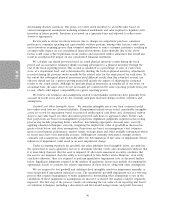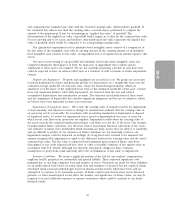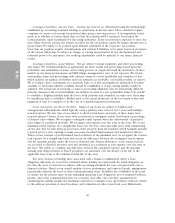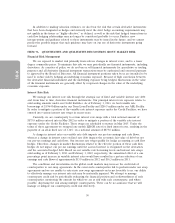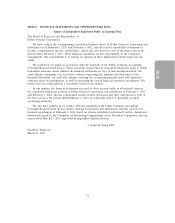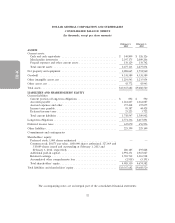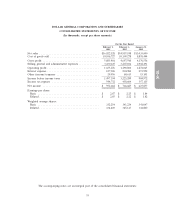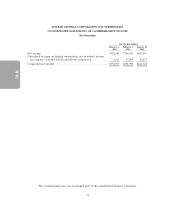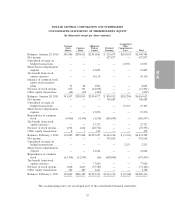Dollar General 2012 Annual Report Download - page 124
Download and view the complete annual report
Please find page 124 of the 2012 Dollar General annual report below. You can navigate through the pages in the report by either clicking on the pages listed below, or by using the keyword search tool below to find specific information within the annual report.
10-K
Accounting Standards
In February 2013, the Financial Accounting Standards Board issued an accounting standards
update which will revise the manner in which entities report amounts reclassified out of other
comprehensive income in their financial statements. We are in the process of evaluating this guidance,
which will be effective for us in the first quarter of 2013. At the current time, we do not expect this
guidance to have a material effect on our consolidated financial statements.
Critical Accounting Policies and Estimates
The preparation of financial statements in accordance with U.S. GAAP requires management to
make estimates and assumptions that affect reported amounts and related disclosures. In addition to
the estimates presented below, there are other items within our financial statements that require
estimation, but are not deemed critical as defined below. We believe these estimates are reasonable and
appropriate. However, if actual experience differs from the assumptions and other considerations used,
the resulting changes could have a material effect on the financial statements taken as a whole.
Management believes the following policies and estimates are critical because they involve
significant judgments, assumptions, and estimates. Management has discussed the development and
selection of the critical accounting estimates with the Audit Committee of our Board of Directors, and
the Audit Committee has reviewed the disclosures presented below relating to those policies and
estimates.
Merchandise Inventories. Merchandise inventories are stated at the lower of cost or market with
cost determined using the retail last-in, first-out (‘‘LIFO’’) method. Under our retail inventory method
(‘‘RIM’’), the calculation of gross profit and the resulting valuation of inventories at cost are computed
by applying a calculated cost-to-retail inventory ratio to the retail value of sales at a department level.
The RIM is an averaging method that has been widely used in the retail industry due to its practicality.
Also, it is recognized that the use of the RIM will result in valuing inventories at the lower of cost or
market (‘‘LCM’’) if markdowns are currently taken as a reduction of the retail value of inventories.
Inherent in the RIM calculation are certain significant management judgments and estimates
including, among others, initial markups, markdowns, and shrinkage, which significantly impact the
gross profit calculation as well as the ending inventory valuation at cost. These significant estimates,
coupled with the fact that the RIM is an averaging process, can, under certain circumstances, produce
distorted cost figures. Factors that can lead to distortion in the calculation of the inventory balance
include:
• applying the RIM to a group of products that is not fairly uniform in terms of its cost and
selling price relationship and turnover;
• applying the RIM to transactions over a period of time that include different rates of gross
profit, such as those relating to seasonal merchandise;
• inaccurate estimates of inventory shrinkage between the date of the last physical inventory at a
store and the financial statement date; and
• inaccurate estimates of LCM and/or LIFO reserves.
Factors that reduce potential distortion include the use of historical experience in estimating the
shrink provision (see discussion below) and an annual LIFO analysis whereby all SKUs are considered
for inclusion in the index formulation. An actual valuation of inventory under the LIFO method is
made at the end of each year based on the inventory levels and costs at that time. Accordingly, interim
LIFO calculations are based on management’s estimates of expected year-end inventory levels, sales for
the year and the expected rate of inflation/deflation for the year and are thus subject to adjustment in
the final year-end LIFO inventory valuation. We also perform interim inventory analysis for
45


